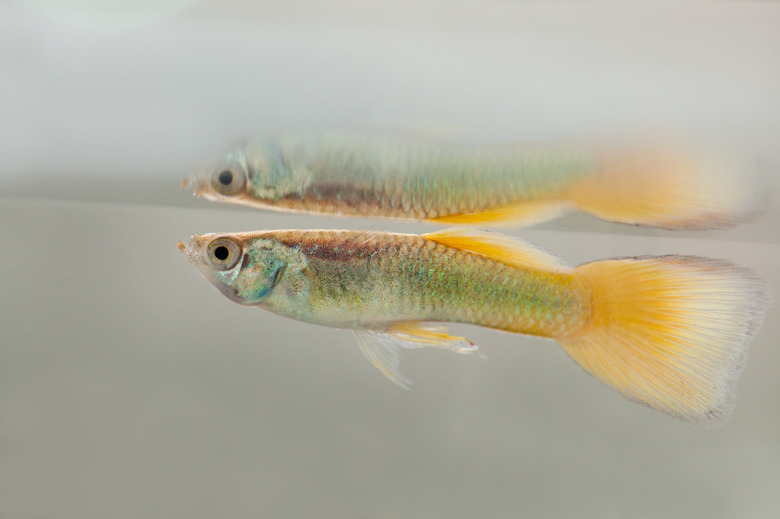Guppy Pregnancy Stages
Guppies now come in many strains characterized by vivid colors and ornate tails. They add variety and interest to an aquarium.They are prolific breeders who need no mating or birthing assistance from you — but if you understand the timeline of guppy pregnancy, you'll know what to expect and when.
Meet the Guppies
Meet the Guppies
Guppies, peaceful in nature, make excellent community tank fish. Female guppies grow to lengths of about 2 inches. Males reach about an inch and a half and are usually more brightly colored than females.
Guppies are hardy fish; they can usually withstand the fluctuations in conditions that can occur in budding aquarists' tanks — but you should try to provide the best possible conditions to ensure optimal health. Guppies do well on a diet of commercial tropical fish food; they generally live 12 months to three years in captivity.
Prolific Livebearers
Prolific Livebearers
Guppies are livebearers, which means females are internally fertilized by males and give birth to live babies rather than lay eggs. Males are fully mature at about 2 months of age and females at about 3 months.
After mating, females use some of the sperm immediately to fertilize eggs and store the rest for future pregnancies — they can produce young every four weeks for as long as eight months without mating again.
Look at the Gravid Spot
Look at the Gravid Spot
The first sign that a guppy is pregnant is a yellowish-brown triangle-shaped spot where the guppy's abdomen meets the tail. This is called the gravid spot — gravid means carrying eggs. This spot is caused by developing embryos showing through the mother's translucent abdomen.
As the guppy progresses through gestation, the gravid spot gets larger and darker as the babies develop. A pregnant guppy's abdomen will also grow noticeably larger as she gets closer to the birth of the babies. It may even affect her swimming ability.
A few days before giving birth, the gravid spot will appear black, due to the embryos' large, dark eyes. Typically, a guppy approaching the birth of her young will seek privacy and a place to hide.
The Arrival of the Fry
The Arrival of the Fry
After about 30 days, a female guppy will give birth to her babies, or fry. If possible, move her to a separate tank, as other fish will eat the fry — move the mother back to the main tank after the birth, as she will also attempt to eat her young.
Guppies generally give birth to between five and 20 babies — but can have 100 or more — at a time. Feed the fry newly hatched brine shrimp twice a day. In a few days, you can add flake and frozen food. In two to three months, the guppies will be mature, ready to start the life cycle all over.
